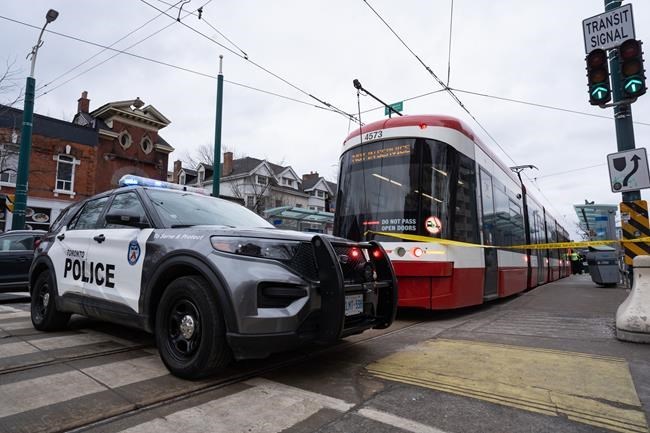TORONTO — As Canadian cities look for ways to combat violence on public transit, experts say strategies south of the border that combine law enforcement, social supports and community engagement could offer new solutions.
Violence on transit has captured national attention in recent weeks – a 17-year-old boy was fatally stabbed on a Vancouver-area bus last week, a man had life-threatening injuries after his throat was slashed on a Surrey, B.C., bus earlier this month, and a 16-year-old boy was stabbed to death in an unprovoked attack at a Toronto subway station in March.
Those high-profile cases were among many other instances of aggression on transit in several cities. Transit agencies and police have been working to understand what's driving the violence, with some pointing to the pandemic as a factor.
Experts say some American cities have taken a multi-pronged approach to violence on transit, addressing issues like housing, mental health and substance abuse in parallel with security issues as they work to make subways, buses and stations safer.
The Southeastern Pennsylvania Transportation Authority, which serves the city of Philadelphia and surrounding areas has drawn particular interest.
Its SCOPE program – which stands for safety, cleaning, ownership, partnership and engagement – connects vulnerable residents with social services and aims to keep the transit system safe and clean for those who use it. It involves police and social workers but also features partnerships with art programs and a pilot project that sees medical students help provide health resources.
"The SCOPE program in Philadelphia has been looked upon with great interest in the transit sector right now because the agencies are looking for a bit of a North Star," said David Cooper, founder of Toronto-based transit planning firm Leading Mobility.
"The SEPTA SCOPE program is probably one of the ones where they've had the most number of tools deployed."
SCOPE staff offer a suite of outreach services to vulnerable people on transit but if those are refused, the person is not given the option to linger in the system, Cooper said.
"They're informed they have to leave the station and there's a lot of complexity with that," said Cooper, who has held transit planning and policy roles in Calgary, Vancouver and Toronto.
Social issues including housing and mental health converged on public transit in recent years because that was one of the few public spaces that remained open during the COVID-19 pandemic, said Cooper.
Transit agencies responded with approaches that pair safety officers with outreach workers but the challenge is those efforts require building trust to really be effective, Cooper said.
"When it comes to these complexities, transit operators or transit systems are responsible for moving people," he said. "They don't have the skill sets when it comes to mental health, addictions and housing."
Philadelphia's transit system also runs a program called SAVE – which stands for saving a vulnerable entity. It sees police and social workers pair up on the transit system but focuses more on engagement and relationship-building over enforcement, said Jerry Ratcliffe, a criminal justice professor at Temple University in Philadelphia.
Early observations show vulnerable populations on transit are more likely to accept support services if they have an existing relationship with an authority figure, said Ratcliffe, who is studying the program.
"The combined work of the police officer and the social workers is very good. A lot of the time the social workers are pleased to have the police officer there, not just for their safety but because for the transit authorities the goal continues to be trying to create a safe and welcoming environment for customers," he said.
"It's still useful for the public to see that there are police officers around and they're engaging with people to try and help them get into treatment and shelter."
Efforts by the transit system in Los Angeles have also drawn attention.
Toronto-based Cooper, who has been studying the Los Angeles County Metropolitan Transportation Authority, said the agency reimagined one of its busiest stations to improve public safety after the hub experienced many drug overdoses and calls to police.
The changes included working with neighbourhood, city and county partners to transform a plaza outside the station into a community space that hosts local entrepreneurs and events, adding lighting and security cameras, installing a kiosk to assist customers and having more safety ambassadors and homeless outreach teams on the ground.
"What they're doing in L.A. is they identified an inventory of all the different components of what's happening at the station," Cooper said.
What's missing from the Canadian response, Cooper said, is operating funding to fill transit budget shortfalls coming out of the pandemic. Those funds could come from federal and provincial governments, he said.
Service cuts and smaller investments in transit could lead to a "death spiral" for the systems, he said, making transit less attractive, which could see ridership drop and opportunity for crime rise.
There also needs to be greater collaboration and data-sharing between transit agencies, police, city departments and other agencies, he said.
"How we actually determine a program and effectiveness is very challenging right now because we have all these different data sources at different points," Cooper said. "We need to actually get a full picture of what's going on."
This report by The Canadian Press was first published April 20, 2023.
Tyler Griffin, The Canadian Press


